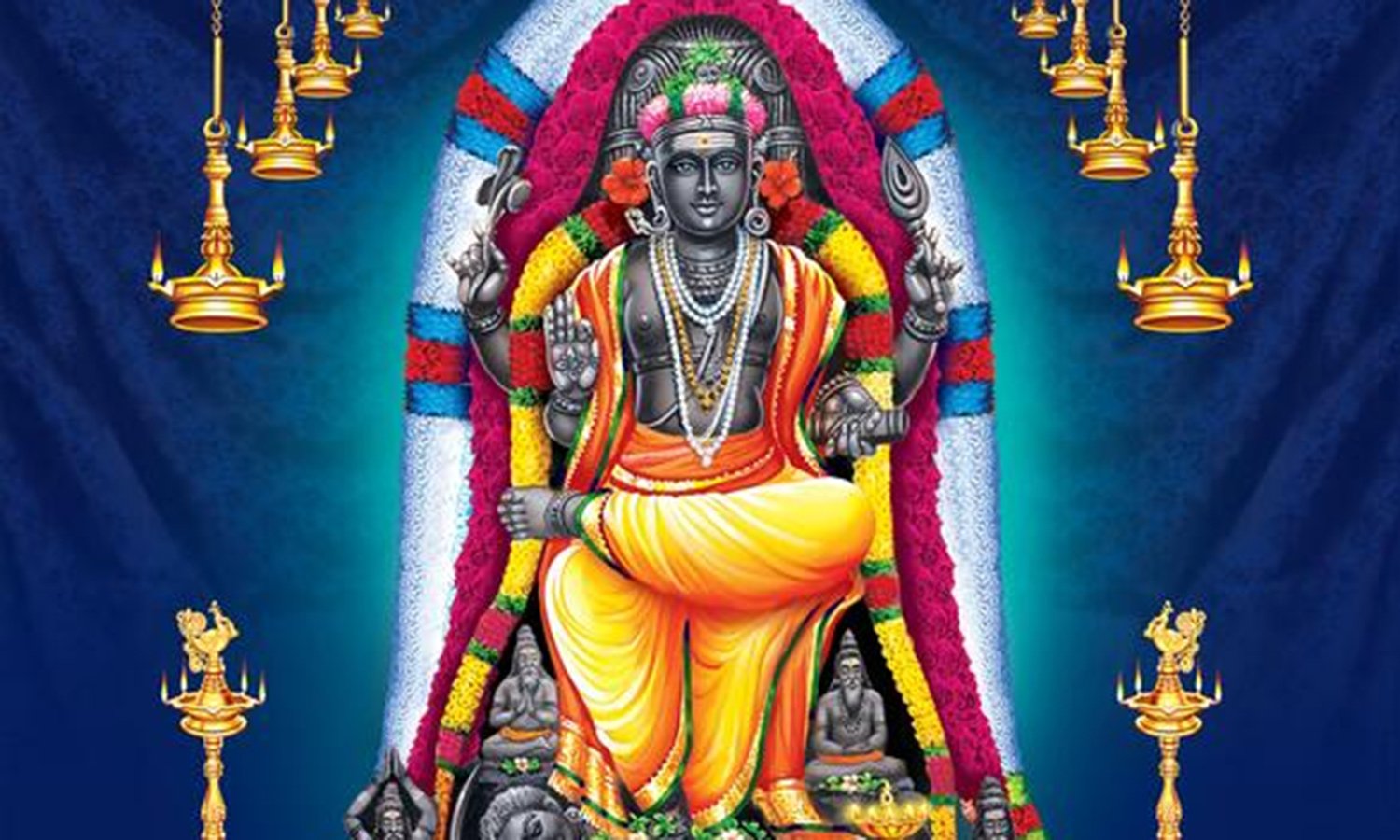Guru, Jupiter is the largest planet in the solar system and the fifth from the Sun. He is one of the planets with the most beneficent energies because of his masculine energy. Lord Dhakshinamoorthy is the deity in charge. Jupiter rules Punarvasu, Vishakha, and Purvabhadra, as well as the zodiac signs Sagittarius and Pisces. It takes him one year to traverse each zodiac sign, and it takes him twelve years to traverse all 12 signs.
Jupiter is also known as Guru, Brihaspati, Devaguru, Viyazhan, Mannan, and Gnani. Jupiter, the vast planet, is associated with character, seriousness, meditation, prayer, success, honor, and fortune. It is also associated with karma from previous births, divine favor, fame, religious thought, wealth, good character, honesty, justice, and health. He represents wealth and children. Jupiter is in charge of the lower abdomen, hearing, blood circulation, hip, and liver in a human body.
Jupiter is the son of Saint Angirasa, one of Lord Brahma’s favorite sons, and Chitra Devi. The wife of Jupiter is Tharai. Some people believe that Nari is the name of Jupiter’s wife and that he is the son of Anniethiran and Poorvasithi. Guru is depicted riding a horse-drawn chariot or standing in front of a white elephant while holding a conch, chakra, and lotus. He is dressed in yellow. He is sometimes shown with four hands holding a rosary, lotus, and conch, as well as sitting on a lotus.
At Benares, Jupiter performed penance for ten thousand years by consecrating the Lord Shiva idol known as the Lingam. Lord Shiva appeared before him and announced that he would be referred to as JEEVAN by the general public and would hold the position of Guru for the Devas.
Jupiter is a representation of the Divine spirit and eternal intelligence. He is eager to share, full of fun, and filled with joy. Strong Jupiter promotes health and happiness, as well as an affinity for management, education, religion, astronomy, and astrology. Overoptimism, unnecessary expenditures, waste of resources, marital and relationship issues, childbirth, and a lack of wisdom could all result from Jupiter being afflicted. Jupiter is a sign of our spirit’s expansiveness; however, his position in a person’s birth chart is a sign of grace and fortune.
Alangudi, located in the southern part of Tamilnadu, is Jupiter’s most important power station. Thursday is the day of the week that is devoted to him, and the color yellow is used to represent it. Yellow Topaz and Yellow Sapphire are the gemstones associated with Jupiter. Jupiter is honored by dedicating yellow flowers. Offering a chickpea (White Channa) mala and white Channa as prasad to Jupiter on Thursday is one powerful way to worship him.
A Hindu temple dedicated to Shiva is the Apatsahayesvarar Temple, Alangudi or Tiru Irum Poolai. It is in the village of Alangudi in the Valangaiman taluk of the Tiruvarur district in the Indian state of Tamil Nadu. The lingam represents Shiva, who is revered as Apathsahyesvarar. Elavarkuzhali is portrayed as Parvati, his wife. In the Tamil Saiva canonical work Tevaram, which was written by Tamil saint poets known as the Nayanmars and is categorized as Paadal Petra Sthalam, the presiding deity is praised.
Two acres of the temple complex are occupied by a five-tier gateway tower known as gopurams, one of which faces the Apathsaheswarar shrine and the other to the north. There are several shrines in the temple, the most prominent of which are dedicated to Elavarkuzhali and Apathsaheswarar.
From 6:00 a.m. to 8:30 p.m., the temple has six daily rituals and four annual festivals on its calendar. The most well-known festival is Brahmotsavam, which takes place in Chittirai (April–May).
The current masonry structure was constructed by the Nayak in the 16th century, whereas the Cholas are thought to have built the original complex.
According to legend, Siva ingested lethal poison, which gave rise to the name “Alangudi” and gave the deity the name “Apatsahayesvarar,” which means “savior” in difficult times. Aranyeswarar is another name for the presiding deity. The temple is associated with sixteen waterbodies.
The puja (rituals) are performed by temple priests on a daily basis and during festivals. Six times a day, the temple rituals are performed; Kalasanthi begins at 6:00 a.m., Irandam Kalm begins at 9:00 a.m., Uchikalam begins at 12:00 a.m., Sayarakshai begins at 6:00 p.m., Irandam Kalm begins at 7:30 p.m., and Arthajamam begins at 9:00 p.m. for Apatsahayesvarar and Elavarkuzhali, abhisheka (a sacred bath), alangaram (decoration), naivethanam (a food offering), and deepa aradanai (the waving of lamps) were performed. There are monthly festivals like amavasai (new moon day), kiruthigai, pournami (full moon day), and sathurthi, as well as weekly rituals like somavaram (Monday) and sukravaram (Friday). Vinayaka Chaturthi, Aadi Pooram, Navaratri, Skanda Sashti, Kartikai Deepam, Arudra Darisanam, Thaipusam, Maasi Magam, Panguni Uththiram, and Vaikasi Visakam are additional festivals. The temple’s most important festival is Brahmotsavam, which takes place in the Tamil month of Chittirai (April–June). During this time, special worship practices are observed, and the festival image of the deity is paraded through Alangudi’s streets.

